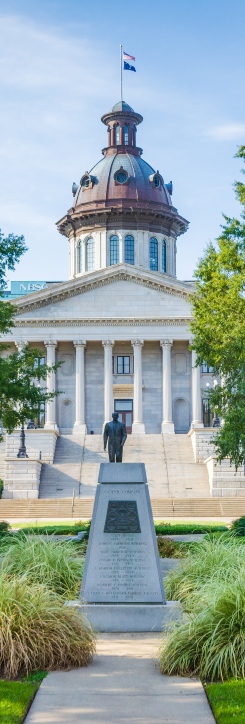STATE OF EDUCATION FUNDING
South Carolina
Fair school funding systems ensure that districts, schools, and ultimately students receive significant additional funding according to their specific needs. Providing high-quality learning opportunities for students living in poverty, English learners, students with disabilities, and rural students requires additional resources.
According to The Education Trust’s State of Funding Equity, in South Carolina:
- The highest poverty districts receive $855 or 6.7% more state and local revenue than the lowest poverty districts.
- The districts serving the most students of color receive $1,278 or 9.9% more state and local revenue per student than the districts serving the fewest students of color.
- The districts serving the most English learners receive $925 or 6.9% less state and local revenue per student than the districts serving the fewest English learners.
For more information about how these data compare with other states or district specific information, see The Education Trust’s State of Funding Equity report.


Learn more about
how South Carolina
funds students
According to EdBuild, “South Carolina has a hybrid funding formula incorporating both student-based calculations and extensive program-based allocations. It assigns a cost to the education of a student with no special needs or services, called a base amount, and provides increased funding to educate specific categories of students. The categories of students considered in South Carolina’s funding policy are students in certain grade levels, English-language learners, students from low-income households, students with disabilities, students identified as gifted, and students enrolled in career and technical education (CTE) programs.”
The Education Law Center’s 2023 Making the Grade Report rated South Carolina’s school funding:
- C on per-pupil funding relative to the national average.
- C on the percentage difference in per-pupil funding in high-poverty districts relative to low-poverty districts.
- B on the PK-12 funding as a percentage of state GDP.
How fair is South
Carolina’s Funding?
Using criteria developed based on research, best practice, and what we believe, we provide ratings for South Carolina’s school funding formula below. Our goal is for states to build a simplified, student-weighted funding formula guided by students’ different levels of need with the goals of eliminating achievement and opportunity gaps. We aim for states to create adequate, equitable, and transparent formulas that provide clear dollar allocations by assigning additional “weights” for students from low-income families, English learners, students with disabilities, and rural students.
For more on how we determined our ratings for South Carolina click here.
See our ratings across states, an explanation of the criteria we used to differentiate between state funding systems, and explanations of our specific state rankings here.
| Rating | Reason for Rating | |
|---|---|---|
| FUND STUDENTS ADEQUATELY | ||
| The funding formula is student-based, or weighted | Yellow | The formula is a hybrid model |
| Per-pupil funding is adequate enough for all students to achieve average, national test scores | Red | There is high percentage of students attending schools in inadequately funded districts |
| FUND STUDENT NEEDS APPROPRIATELY | ||
| Formula includes a weight or additional funding for students living in poverty | Yellow | The formula includes a 20% weight for students living in poverty |
| Formula includes a weight or additional funding for English learners | Yellow | The formula includes a 20% weight for English learners |
| Formula includes a weight or additional funding for students with disabilities | Green | The formula includes multiple SPED weights based on 10 different disability categories |
| Formula includes a weight or additional funding for sparse and/or isolated districts | Red | The formula does not include a sparsity weight |
| Formula includes weights or additional funding for districts with high levels of concentrated poverty | Red | The formula does not include a weight for concentrated poverty |
| FUND SCHOOL DISTRICTS EQUITABLY | ||
| State caps how much local revenue districts can raise to limit between-district disparities in local revenue | Red | The formula does not set a limit for how much local revenue districts can raise |
| FUND STUDENTS TRANSPARENTLY | ||
| State annually publishes information about how the funding system is designed to work in clear, plain language | Yellow | The state education department publishes a funding manual that explains the overall structure of the formula, but the document is not user friendly |
| State reports school spending data in alignment with equity-oriented principles | Yellow | The state reports are partially aligned with equity-oriented school spending reporting principles |
| PUBLIC FUNDS FUND PUBLIC SCHOOLS | ||
| Taxpayer funds are used to maintain and support public schools exclusively | Yellow | The state has a means-tested ESA program; Eligibility includes previous attendance at a public school |
Who’s Who
in South Carolina
Legislature
The South Carolina General Assembly is the legislative body of South Carolina. The bicameral body is composed of a House of Representatives with 124 members and a State Senate has 46 members. The Senate has a standing committee focused solely on Education and the House of Representatives has a standing committee on Education and Public Works. In 2024, the legislature will convene January 9, 2024 and adjourn no later than May 9, 2024.
State Superintendent of Education
The South Carolina State Superintendent of Education is an elected constitutional officer. The superintendent serves four-year terms. The current superintendent was elected in 2023.
State Board of Education
The South Carolina State Board of Education is composed of 17 members. One member per circuit is appointed by legislators from each of the state’s 16 judicial circuits. The remaining member is appointed by the governor. Members are appointed to four-year terms.

